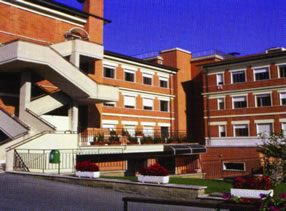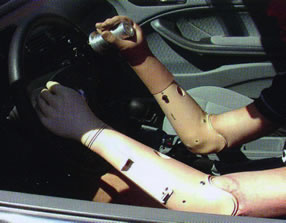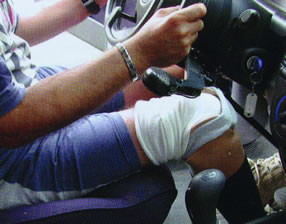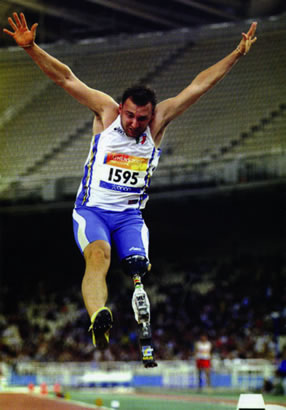From the blanket of smog covering the megalopolis filters the artificial light brightening the stadium filled with heated up and enthusiastic spectators for one of the culminating points in the XXIX Olympics: the 400-meter race. Athletes are positioning themselves at the departure line, waiting for the starter to set free the adrenaline. One of them jumps, seemingly reflecting headlights. Yet, it is not a sensation from the pre-race tension. There are actual light glares coming from his legs.
With a better look, we see that they are not human-looking legs, but a projection in the future for us, uninformed, curious and intimidated spectators. These are two prosthesis, two blades ready to slice the wind, to assault the track, to spring to victory. The spectators' whispering is growing into an uproar, everyone now recognizes him: it's him, Oscar Pistorius, the bionic athlete. It almost seems like a dream, to see a man, who has lost his legs when he was still a newborn, fight for the gold medal against those who are "normal". And in fact it is a dream. The athlete with a prosthesis was not admited by the IAAF to compete with abled-bodied athletes and will have to "settle" for the Paralympics. And yet, Pistorius is not at all an exception, a technical miracle performed for a famous sportsperson. Anything but. By going to INAIL, the Centre for the Experimentation and Application of Prostheses and Orthopaedic Aids at Virgoso di Budrio, one understands that the use of prostheses, even highly complex ones, is meant for anyone who is missing a limb. The highly specialized facility has its headquarters in Villa Zanardi, in the Bolognese countryside.
In 1943, INAIL bought Villa Zanardi, maintaining the previous function and denomination of convalescent home. The structure temporarily housed Bologna's Orthopaedic Trauma Centre which was transferred in the country's peacefulness following the damaged caused to the city's bombing raids. In 1961, the convalescent home was transformed in a Functional Rehabilitation Centre with an Orthopaedic Workshop. It was entrusted to Professor Johannes Schmidl (until 1992). He headed a research group on myoelectric prostheses. The patent was later donated to the World Health Organization.
The Centre (acquiring in 1984 the denomination, still used today, Centre for the Experimentation and Application of Prostheses and Orthopaedic Aids) impresses visitors right from the first step into the facility. Not only because the large windows allow people to admire the technicians at work in one of the orthopaedic workshops, right next to the reception area, enhancing the integration between the different rooms and the interaction between the various functionalities of the centre. But, also for the image (which will be confirmed with facts) of extreme professionalism and courtesy which perspires from every single detail in the structure. One has the distinct impression that the professionals are devoted to their work and that they derive a lot of satisfaction from it.
In enumerating the names of the professionals who were there on the visit of Vedere Oltre (Dr. Simona Amadesi, Director of Communication and Marketing, Ing. Rinaldo Sacchetti, Technical Director, Prof. Tancredi Andrea Moscato, Principal Physiatrist, Dr. Francesca Baldassarri, Psychologist, Dr. Ilaria Giovannetti, Social Therapist), we understand the specificity of the Centro protesi INAIL: multidisciplinarity.
The prosthetic-rehabilitative treatment begins with the first visit upon admittance at the Centre.
Five specialists participate in that appointment: the
orthopaedic technician, the physician, the physiotherapist, the
psychologist and the social therapist, together with the health and
welfare professional. On that occasion, the physician writes the patient's
clinical chart and the health treatment and rehabilitation plan. The
orthopaedic technician identifies the most adequate aids, which are
tailor-made. The physiotherapist accompanies the patient in the training
phase with the prosthesis. The psychologist and the social therapist help
the patient in the management of the inevitable issues arising from the
amputation as well as the reintegration into daily life. Finally, the
nurse assists the patient daily during his stay in the Centre, carrying
out very delicate tasks (such as personal hygiene care and injury
treatment).
The treatment has various control periods, always done in
team, until the patient leaves the facilities (but also eventually, with
the periodical replacement of the prostheses). The patient is usually
discharged not many months later, but rather from 15 to 60 days following
his acceptance. If we consider that the Centre has 90 beds (besides the
one-day stays and many community clinics), the quality and efficiency of
the therapeutic treatment represent the only way to succeed in seeing
14,000 patients each year (of which 10,500 are amputated of their lower
limbs) not only INAIL insured, but those also sent by the LHA and a
certain number of foreigners. The work of the Centro INAIL in Vigorso does
not end with the patients' discharge. The philosophy has always been to
promote patients' social reintegration, and therefore into the workforce,
guaranteeing the highest degree possible of autonomy. Consequently, the
Centre has advisory services such as the elimination of architectural
barriers (in civil and work environments), the acquisition of special
driving licences, the adaptation of vehicules for the needs of those who
use prostheses, career reorientation, etc. Individuals are considered as a
whole and the Centre also creates prostheses for sports activities,
following closely many athletes participating in the Paralympics (which
were inaugurated in 1960 in Rome thanks to the Vigorso Centre) as well as
those who participate in amateur competitions.
The daily challenge
following the loss of a limb (but also in cases of congenital malformation
and paraplegia) is overcome, thanks to the interdisciplinary approach but
also the scientific research that, as was said, has always been a
prerogative of the Vigorso Centre. The research is self-financed, but
aside from internal resources, collaborative projects are developed with
other private and public organizations, ensuring continuous results which
translate into funds from local (Emilia-Romagna Region) and international
(European Union) entities. And the Centre also is a major participant in
international exhibitions such as Expo Sanità (in Bologna, end of May).
When the Bolognese Formula 1 pilot, Alessandro Zanardi, lost both of
his legs in a terrible accident during a Champ Car competition, everyone
thought the worse, that he was condemned to only live for his souvenirs.
Instead, still today, he races in a monoplace at unthought of speed for
any one of us. Behind this success is certainly Zanardi's very strong
determination, but also that of the people of Vigorso, making it possible
for every person going to Centro INAIL to rise to their own challenge in
the face of disability to




return to normalcy (and not all usually race up to 300
km/hr on motor racing circuits or do 10'91'' in a 100-meter race).
Paradoxically, it is because of the research work of the Vigorso Centre
that it is now possible to declare that athletes who have two prostheses
according to Pistorius' standard are now advantaged in regards to
abled-bodied athletes because they are so performing.
However, we are
not duped: as stated by IAAF, it is only another injustice imposed on the
"differently-abled" who remain confined behind a fence (in the case of
Pistorius, the "advantage" on a straight track is nevertheless inferior to
the deficit recorded at the starting point and in curves).
The true
competition against disability is won every day. Beyond the rhetoric, away
from the spotlight. Dedicating oneself and one's own professionalism to
closing the gap that, unexpectedly, traps amputees.
It is the
competition that takes place every day at the Centro INAIL di Vigorso,
where everyone there wins a medal with the colour of a prosthesis and a
flash of the possibility to be again ourselves.